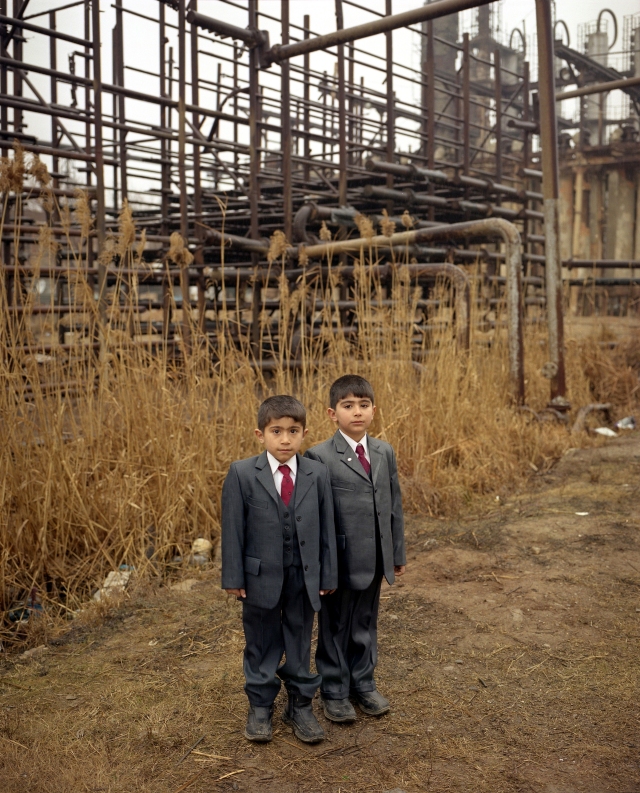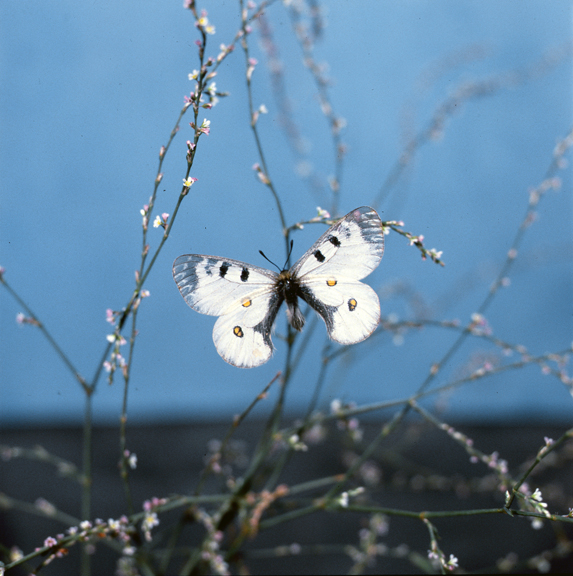Liquid Land by Rena Effendi was shown at Impressions Gallery from 26th April to 22nd June 2013. Rena did a talk about herself and the work, which took place at Impressions Gallery on 11th May

Pig butchered for the New Year holidays in Kapavati village. Chernobyl, Ukraine (2010) © Rena Effendi/Prince Claus Fund/INSTITUTE
“Liquid Land depicts communities and refugees of war living amongst the oil spills and industrial ruin of the petroleum-rich Absheron peninsula in Azerbaijan, near to the capital Baku where Effendi was born and grew up. These landscapes and portraits are paired with images that pay tribute to Effendi’s late father, a dissident scientist and entomologist who devoted his life to studying and collecting butterflies in the Soviet Union. The only remaining visual evidence of his life’s work is a collection of photographs of endangered butterflies for a manuscript he never published.” (Quote from Impressions Gallery website)
Rena is a trained linguist, and worked as a translator and economist from the age of 19. She spoke about her urge to find a way to express herself creatively and first tried her hand at painting. I liked it when she said “It was literally my frustration with painting that led me to photography” because she then went on to explain that she felt the need to be around people, meeting new people and not working alone, painting in a studio. Her attitude confirms that she is a great people photographer, because she wants to be out and about photographing people. Rena really seems to care about the people she works with- “I don’t have that judgement, I don’t come in there with an idea in my head that these people are very unhappy in fact they’re some of the happiest people I have met.” I think it’s really important that photographers get to know their subjects so they can capture their personality.

School boys in a refugee settlement at the abandoned gas processing factory. Bibi-Heybat. Baku, Azerbaijan (2008) © Rena Effendi/Prince Claus Fund/INSTITUTE
I particularly identified with Rena when she spoke about her dilemma between her regular day job, with a scholarship to study in America and risking it all to follow her passion– “I turned down the scholarship and I stayed in Azerbaijan and I decided that I want to become a photographer, but it took me three years to finally leave my day job and become a full-time photographer” … “It, was a very hard choice to make, just giving up the monthly pay check. It was a very hard decision for the unknown but it was something I just couldn’t do any more, I just wanted to be on the streets taking pictures.” I find this quote very inspiring, as a recent photography graduate, I fully identify with that risk to become a full-time photographer. Her risk has obviously paid off.
Rena links her work to her father in the talk. This is interesting, because there isn’t an obvious family connection in the images. It’s like he has been a personal inspiration and driving force behind her work, and it was great to hear Rena talk about it.
The exhibition features images of butterflies, mixed in with the other images. Rena was asked about these images, and she said that they were taken by her father, who was obsessed with butterflies and left Rena around 50 slides when he passed away. Rena said- “For me they sort of work as punctuation marks, they give you this breathing space to take some time and take a look at the next picture but in a way even in these photographs of the people, the way I see them is there is hope as well.” I really like the idea of images being like punctuation marks. They add another point of interest and variation to the exhibition. These images made me stop and think about why Rena chose to include them in the exhibition.

Parnassius nordmanni. Endangered specie. Habitat: Shah-Dag and Baba Dag mountains of Guba, Azerbaijan © Rena Effendi/Prince Claus Fund/INSTITUTE
My final favourite quote from Rena’s talk, when asked about her choice to move from black and white to colour photographs- “The way I sometimes compare it is like when you study painting, before you study painting, you have to study drawing very hard. You have to work with charcoals and you have to work with pencil and it’s all black and white so you really have to understand the form and the shape of objects that you’re putting on the canvas and then you get into painting, and painting and colour so you have to understand temperatures and you have to understand mixing colour” This is a great analogy. I have always had the option of choosing between colour and black and white for my own photography, and take this for granted. It’s refreshing to hear a justified comparison between the two.
I enjoyed listening to the talk from Rena. It was really interesting to hear about the little stories and analogies behind her images.
For more information visit http://www.impressions-gallery.com/exhibitions/exhibition.php?id=55
